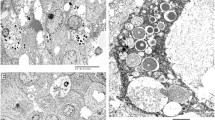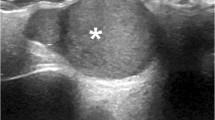Abstract
Mammary analogue secretory carcinoma (MASC) was recently identified as a distinct salivary gland neoplasm, morphologically resembling intercalated duct cell predominant acinic cell carcinoma (AciCC). To determine how frequently MASC has mimicked an intercalated duct cell predominant AciCC, we reviewed AciCC diagnosed from 1956 to 1975. Nine AciCC consecutively diagnosed in that period were identified. Based on morphologic examination, one case diagnosed as AciCC in a male patient in 1960 was re-classified as MASC [confirmed by fluorescence in situ hybridization (FISH) showing ETV6 translocation]. Another case diagnosed as AciCC of the palate in a female patient in 1975 was re-classified as mucoepidermoid carcinoma (based on the lack of acinar differentiation, presence of mucous cells, and confirmed by FISH showing MAML2 translocation). In this proof-of-principle study, we show that 1 in 9 cases historically designated as AciCC represents a MASC. “Intercalated duct cell predominant AciCC”, especially among male patients, most likely represent examples of MASC. For anatomic sites outside of the parotid glands, broader differential diagnoses should be considered before accepting morphologic variants of AciCC as the final diagnosis.



Similar content being viewed by others
References
Nasse D. Die Geschw¸lste der Speicheldr¸sen und verwandte Tumoren des Kopfes. Arch klin chir. 1892;44:233–302.
Buxton RW, Maxwell JH, French AJ. Surgical treatment of epithelial tumors of the parotid gland. Surg Gynecol Obst. 1953;97(4):401–16.
Chiosea SI, Peel R, Barnes EL, Seethala RR. Salivary type tumors seen in consultation. Virchows Archiv Int J Pathol. 2009;454(4):457–66. doi:10.1007/s00428-009-0742-x.
Skálová A, Vanecek T, Sima R, Laco J, Weinreb I, Perez-Ordonez B, et al. Mammary analogue secretory carcinoma of salivary glands, containing the ETV6-NTRK3 fusion gene: a hitherto undescribed salivary gland tumor entity. Am J Surg Pathol. 2010;34(5):599–608. doi:10.1097/PAS.0b013e3181d9efcc.
Griffith C, Seethala R, Chiosea SI. Mammary analogue secretory carcinoma: a new twist to the diagnostic dilemma of zymogen granule poor acinic cell carcinoma. Virchows Archiv Int J Pathol. 2011;459(1):117–8. doi:10.1007/s00428-011-1098-6.
Petersson F, Lian D, Chau YP, Yan B. Mammary analogue secretory carcinoma: the first submandibular case reported including findings on fine needle aspiration cytology. Head Neck Pathol. 2011. doi:10.1007/s12105-011-0283-x.
Ellis GL, Corio RL. Acinic cell adenocarcinoma. A clinicopathologic analysis of 294 cases. Cancer. 1983;52(3):542–9.
Smith MA, Barnes EL, Chiosea SI. Pathology archive: evaluation of integrity, regulatory compliance, and construction of searchable database from print reports. Am J Clin Pathol. 2011;135(5):753–9. doi:10.1309/AJCP3CVA2NAVUUVU.
Lewis JE, Olsen KD, Weiland LH. Acinic cell carcinoma. Clinicopathologic review. Cancer. 1991;67(1):172–9.
Chenevert J, Barnes LE, Chiosea SI. Mucoepidermoid carcinoma: a five-decade journey. Virchows Archiv Int J Pathol. 2011;458(2):133–40. doi:10.1007/s00428-011-1040-y.
Chenevert J, Chiosea S. Incidence of human papillomavirus in oropharyngeal squamous cell carcinomas: now and 50 years ago. Hum Pathol. 2011. doi:10.1016/j.humpath.2011.03.009.
Hirokawa M, Sugihara K, Sai T, Monobe Y, Kudo H, Sano N, et al. Secretory carcinoma of the breast: a tumour analogous to salivary gland acinic cell carcinoma? Histopathology. 2002;40(3):223–9.
Tognon C, Knezevich SR, Huntsman D, Roskelley CD, Melnyk N, Mathers JA, et al. Expression of the ETV6-NTRK3 gene fusion as a primary event in human secretory breast carcinoma. Cancer Cell. 2002;2(5):367–76.
Knezevich SR, Garnett MJ, Pysher TJ, Beckwith JB, Grundy PE, Sorensen PH. ETV6-NTRK3 gene fusions and trisomy 11 establish a histogenetic link between mesoblastic nephroma and congenital fibrosarcoma. Cancer Res. 1998;58(22):5046–8.
Knezevich SR, McFadden DE, Tao W, Lim JF, Sorensen PH. A novel ETV6-NTRK3 gene fusion in congenital fibrosarcoma. Nat Genet. 1998;18(2):184–7. doi:10.1038/ng0298-184.
Argani P, Fritsch M, Kadkol SS, Schuster A, Beckwith JB, Perlman EJ. Detection of the ETV6-NTRK3 chimeric RNA of infantile fibrosarcoma/cellular congenital mesoblastic nephroma in paraffin-embedded tissue: application to challenging pediatric renal stromal tumors. Mod Pathol. 2000;13(1):29–36. doi:10.1038/modpathol.3880006.
Eguchi M, Eguchi-Ishimae M, Tojo A, Morishita K, Suzuki K, Sato Y, et al. Fusion of ETV6 to neurotrophin-3 receptor TRKC in acute myeloid leukemia with t(12;15)(p13;q25). Blood. 1999;93(4):1355–63.
McCook A. Death of a pathology centre: shelved. Nature. 2011;476(7360):270–2. doi:10.1038/476270a.
Bhaskar SN. Acinic-Cell Carcinoma of Salivary Glands. Report of Twenty-One Cases. Oral Surg Oral Med Oral Pathol. 1964;17:62–74.
Abrams AM, Cornyn J, Scofield HH, Hansen LS. Acinic cell adenocarcinoma of the major salivary glands. A clinicopathologic study of 77 cases. Cancer. 1965;18:1145–62.
Horsman DE, Berean K, Durham JS. Translocation (11;19)(q21;p13.1) in mucoepidermoid carcinoma of salivary gland. Cancer Genet Cytogenet. 1995;80(2):165–6.
Seethala RR, Dacic S, Cieply K, Kelly LM, Nikiforova MN. A reappraisal of the MECT1/MAML2 translocation in salivary mucoepidermoid carcinomas. Am J Surg Pathol. 2010;34(8):1106–21. doi:10.1097/PAS.0b013e3181de3021.
Acknowledgments
We are grateful for excellent support by the Developmental Laboratory, Department of Pathology, University of Pittsburgh Medical Center.
Conflict of interest
The authors declare that there is no conflict of interests in this study.
Author information
Authors and Affiliations
Corresponding author
Rights and permissions
About this article
Cite this article
Lei, Y., Chiosea, S.I. Re-Evaluating Historic Cohort of Salivary Acinic Cell Carcinoma with New Diagnostic Tools. Head and Neck Pathol 6, 166–170 (2012). https://doi.org/10.1007/s12105-011-0312-9
Received:
Accepted:
Published:
Issue Date:
DOI: https://doi.org/10.1007/s12105-011-0312-9




